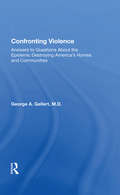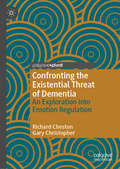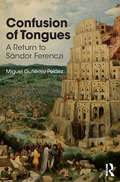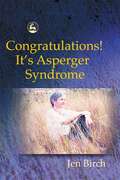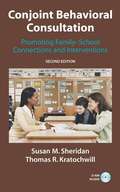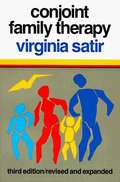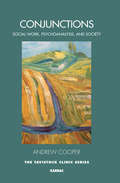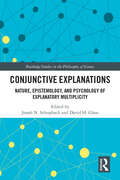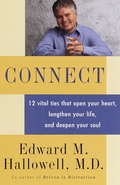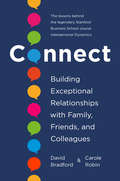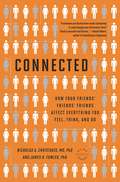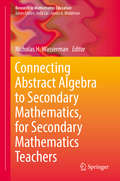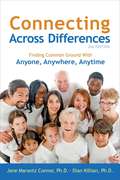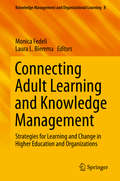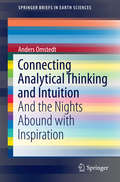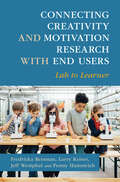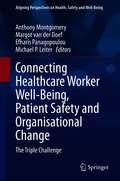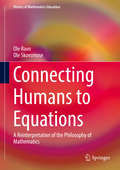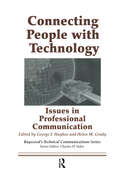- Table View
- List View
Confronting Racism: Integrating Mental Health Research into Legal Strategies and Reforms
by Robert T Carter Thomas D ScheuermannThis book proposes a comprehensive approach to confronting racism through a foundational framework as well as practical strategies to correct and reverse the course of the past and catalyze the stalled efforts of the present. It will do so by focusing on those specific aspects of law and legal theory that intersect with psychological research and practice. In Part I, the historical and current underpinnings of racial injustice and the obstacles to combating racism are introduced. Part II examines the documented psychological and emotional effects of racism, including race-based traumatic stress. In Part III, the authors analyze the application of forensic mental health assessment in addressing race-related experiences and present a legal and policy framework for reforming institutional and organizational policies. Finally, in part IV the authors advocate for a close, collaborative approach among legal and mental health professionals and their clients to seek redress for racial discrimination. Confronting Racism provides a framework for legal, mental health, and other related social science professionals and leaders to acknowledge and act on the harmful aspects of our societal systems.
Confronting Violence: Answers To Questions About The Epidemic Destroying America's Homes And Communities
by George A. GellertThis book is a definitive reference work and a call to action, written with a public health physician's eye for public safety and a scientist's evenhanded respect for evidence. It is intended for professionals who interact with or provide services to people affected by violence.
Confronting the Child Care Crisis
by James A Rivaldo Ph.D. Stevanne Auerbach Ph.D. Edward ZieglerConfronting the Child Care Crisis is an outstanding, historically important analysis of childcare dynamics and a practical guidebook for change is essential reading about unmet needs of childcare. Based on years of personal, professional experience, facts and problems show how inadequate childcare significantly contributes to a national dilemma of increased family stress. Recounting experiences in the federal government, Dr. Auerbach reveals red-tape, overlapping services, mismanagement, wasted resources, and how lack of interest and consistent political support stalled critically important legislation, hampering vital programs that could make a huge difference. Dr. Auerbach shows how childcare leaders can respond to improve services at federal, state and local levels, suggesting ways to build bridges of cooperation between government, industry, and local resources to make important changes and improvements. This book includes President Richard Nixon's 1971 veto message after the bi-partisan approved and endorsed childcare legislation (Title V Child Development Programs of S 2007-Economic Opportunity Amendment). Full statements are included from Senators Walter Mondale and Alan Cranston plus The National Plan of Action presented by the National Women's Conference, held in November, 1977.
Confronting the Existential Threat of Dementia: An Exploration into Emotion Regulation
by Richard Cheston Gary ChristopherThis book explores how dementia acts as an existential threat, both to people diagnosed with the condition, and to their carers. The authors highlight how dementia not only gradually erodes our most fundamental abilities, but that it does so at a time of life when the resources of individuals, couples, and families are already stretched. While over time many people who are living with dementia are able to adapt to their diagnosis and acknowledge its impact on them, for many others it remains too threatening and painful to do this. The book draws on examples from clinical practice and experimental studies to argue that a range of responses, such as searching for long-dead parents or clinging to previous identities, all represent ways in which people living with dementia attempt to protect themselves against the emotional impact of the condition. Finally, the authors set out new ways of intervening to boost psychological resources and thereby support people in facing the existential threat of dementia.
Confused, Angry, Anxious?: Why working with older people in care really can be difficult, and what to do about it
by Bo Hejlskov Elvén Charlotte Agger Iben LjungmannWorking with older people in care can be challenging and frustrating, especially when they behave in ways that seem irrational, aggressive, or unreasonably repetitive, and nothing you can do seems to help. The authors of this useful and practical book explain how to understand the difficult and annoying ways in which older people in care can behave, (especially people with dementia), how to stay calm and kind, and how to solve the problems they can create. With many examples of everyday challenges and how to deal with them, this book has the potential to change your working life.
Confusion of Tongues: A Return to Sandor Ferenczi
by Miguel Gutierrez-PelaezSandor Ferenczi, Sigmund Freud's brilliant pupil as well as an innovative psychoanalyst, was silenced by various generations of his contemporaries until, in the past decades, his work began to be rediscovered. Certain aspects of his trauma theory, in fact, had never been thoroughly addressed, particularly, the connection he made between trauma and language. <P><P>Miguel Gutierrez-Pelaez offers a new reading of Ferenczi by proposing a dialogue between the Hungarian psychoanalyst's work, philosophy, and contemporary psychoanalysis. Among the subjects covered, the book delves into the vulnerability of children and Ferenczi's never-ending search for a cure, the complex issue of war trauma and, more specifically, his anticipatory work in understanding the effects on the human psyche of the horrific experiences in concentration camps during World War II. These issues are raised against the backdrop of captivating figures like Jacques Lacan, Emmanuel Levinas, Giorgio Agamben, Derrida, Nietzsche, and Primo Levi, among others.
Congratulations! It's Asperger Syndrome
by Jen BirchOne of the increasing number of people diagnosed with Asperger Syndrome in adulthood, New Zealand-born Jen Birch relates her story with humour and honesty, taking us through the years of frustration and confusion that led to her diagnosis in 1999. Now that she can put her life experiences into context, she candidly describes her continual search for 'normality', including her experiences at work, her difficulties with relationships, her time spent in a psychiatric hospital and her struggle for correct diagnosis in a country where the syndrome is relatively unknown. Talking positively about how her life has changed since the 'revelation', Jen aims to use this new-found knowledge to inform others about the syndrome and how, once its pros and cons are understood, life can be lived to the full.
Conjoint Behavioral Consultation: Promoting Family-school Connections and Interventions (Second Edition)
by Susan M. Sheridan Thomas R. Kratochwill Jennifer D. Burt Brandy L. Clarke Shannon Dowd-Eagle Diane C. MartiChildren learn within many systems and settings. In the United States, students spend 91% of their time from birth to the age of 18 outside of school. Once in school, they spend 70% of their waking hours outside of school.
Conjoint Family Therapy
by Virginia M. SatirThird edition of this classic on family therapy. The introduction calls it a conceptual frame around which to organize your data and your impressions . . . a suggested path.
Conjunctions: Social Work, Psychoanalysis, and Society (Tavistock Clinic Series)
by Andrew CooperConjunctions engages separately and connectively with therapeutic social work practice, psychoanalytically informed research methods and philosophy, as well as contemporary human service organisational cultures and predicaments, and the societal dynamics affecting social work and psychoanalysis. The chapters are gathered into several thematic sections: Practice, Organisations, Politics Policy and Culture, Research and a final chapter on death, dying and social work. The writing on each topic uses a blend of psychoanalysis, social theory and philosophy to illuminate and develop a psycho-social account of individual, organisational and social processes and dynamics. The author draws directly upon his own and others lived experience of clinical work, organisational stresses and strains, social processes, and research to generate conceptualised accounts of inner and outer experiential worlds in the hope of mobilising emotional and thinking responses in his readership. Conjunctions is therefore intended to be an intervention in modern professional, therapeutic and social life, as well as a contribution to understanding it.
Conjunctive Explanations: The Nature, Epistemology, and Psychology of Explanatory Multiplicity (Routledge Studies in the Philosophy of Science)
by David H. Glass Jonah N. SchupbachPhilosophers and psychologists are increasingly investigating the conditions under which multiple explanations are better in conjunction than they are individually. This book brings together leading scholars to provide an interdisciplinary and unified discussion of such “conjunctive explanations.” The book starts with an introductory chapter expounding the notion of conjunctive explanation and motivating a multifaceted approach to its study. The remaining chapters are divided into three parts. Part I includes chapters on “The Nature of Conjunctive Explanations.” Each chapter illustrates distinct ways in which explanatory multiplicity is motivated by a careful study of the nature and concept of explanation. The second part (“Reasoning About Conjunctive Explanations”) includes chapters on the epistemology and logic of conjunctive explanations. Here the contributors propose and evaluate various norms for reasoning correctly about and to conjunctive explanations. Part III concerns “The Psychology of Conjunctive Explanations,” with contributions discussing conditions under which humans entertain and hold multiple explanations of single explananda simultaneously and the cognitive limitations and capacities for doing so. Conjunctive Explanations will be of interest to researchers and advanced students working on explanation in philosophy of science, epistemology, philosophical logic, and cognitive psychology.
Connect
by Edward M. HallowellThe promise of wellness and satisfaction has never been as ubiquitous in our culture as it is now. Images of happy people stare out at us from magazine pages and television screens; they are successful and busy, hurrying from the office to the opera, eating healthfully and acting responsibly. We are a nation of achievers but, as Dr. Edward Hallowell makes clear in Connect, what sustains us--emotionally, psychologically, physically--is connectedness, the feeling that we are part of something that matters, something larger than ourselves that gives life its meaning, direction, and purpose. Hallowell examines the real life most of us lead--overwhelmed, harried, pressured--and outlines the steps we can take to connect ourselves to the people and things that matter to us. He elevates the simplest forms of communication, understanding, and self-knowledge as examples of the human moment: the basis for the bridges we build to one another. He tells stories of personal growth--one woman's plan to bring a neighborhood together, another woman's assembling of a makeshift family, a real estate developer's institution of company-wide weekly pizza dinners--and identifies in them twelve vital ties to a more connected life. Hallowell concludes that within each of us exists the capacity to connect with the people around us--our parents, spouses, children, friends, and colleagues--to become who we want to be and to be happy with who we are.From the Hardcover edition.
Connect: Building Exceptional Relationships with Family, Friends, and Colleagues
by David Bradford Carole RobinA transformative guide to building more fulfilling relationships with colleagues, friends, partners, and family, based on the landmark Interpersonal Dynamics (&“Touchy-Feely&”) course at Stanford&’s Graduate School of Business&“Carole Robin and David Bradford are masters at helping people bring IQ and EQ together to satisfy both and be successful.&”—Ray Dalio, founder of Bridgewater and author of Principles: Life and WorkThe ability to create strong relationships with others is crucial to living a full life and becoming more effective at work. Yet many of us find ourselves struggling to build solid personal and professional connections or unable to handle challenges that inevitably arise when we grow closer to others. When we find ourselves in an exceptional relationship—the kind of relationship in which we feel fully understood and supported for who we are—it can seem like magic. But the truth is that the process of building and sustaining these relationships can be described, learned, and applied.David Bradford and Carole Robin taught interpersonal skills to MBA candidates for a combined seventy-five years in their legendary Stanford Graduate School of Business course Interpersonal Dynamics (affectionately known to generations of students as &“Touchy-Feely&”) and have coached and consulted hundreds of executives for decades. In Connect, they show readers how to take their relationships from shallow to exceptional by cultivating authenticity, vulnerability, and honesty, while being willing to ask for and offer help, share a commitment to growth, and deal productively with conflict.Filled with relatable scenarios and research-backed insights, Connect is an important resource for anyone hoping to improve existing relationships and build new ones at any stage of life.
Connected: The Surprising Power of Our Social Networks and How They Shape Our Lives
by Nicholas A. Christakis James H. FowlerYour colleague's husband's sister can make you fat, even if you don't know her. A happy neighbor has more impact on your happiness than a happy spouse. These startling revelations of how much we truly influence one another are revealed in the studies of Drs. Christakis and Fowler, which have repeatedly made front-page news nationwide. In CONNECTED, the authors explain why emotions are contagious, how health behaviors spread, why the rich get richer, even how we find and choose our partners. Intriguing and entertaining, CONNECTED overturns the notion of the individual and provides a revolutionary paradigm-that social networks influence our ideas, emotions, health, relationships, behavior, politics, and much more. It will change the way we think about every aspect of our lives.
Connecting Abstract Algebra to Secondary Mathematics, for Secondary Mathematics Teachers (Research in Mathematics Education)
by Nicholas H. WassermanSecondary mathematics teachers are frequently required to take a large number of mathematics courses – including advanced mathematics courses such as abstract algebra – as part of their initial teacher preparation program and/or their continuing professional development. The content areas of advanced and secondary mathematics are closely connected. Yet, despite this connection many secondary teachers insist that such advanced mathematics is unrelated to their future professional work in the classroom. This edited volume elaborates on some of the connections between abstract algebra and secondary mathematics, including why and in what ways they may be important for secondary teachers. Notably, the volume disseminates research findings about how secondary teachers engage with, and make sense of, abstract algebra ideas, both in general and in relation to their own teaching, as well as offers itself as a place to share practical ideas and resources for secondary mathematics teacher preparation and professional development. Contributors to the book are scholars who have both experience in the mathematical preparation of secondary teachers, especially in relation to abstract algebra, as well as those who have engaged in related educational research. The volume addresses some of the persistent issues in secondary mathematics teacher education in connection to advanced mathematics courses, as well as situates and conceptualizes different ways in which abstract algebra might be influential for teachers of algebra. Connecting Abstract Algebra to Secondary Mathematics, for Secondary Mathematics Teachers is a productive resource for mathematics teacher educators who teach capstone courses or content-focused methods courses, as well as for abstract algebra instructors interested in making connections to secondary mathematics.
Connecting Across Cultures: The Helper′s Toolkit
by Pamela A. HaysChock-full of fun exercises, surprising tips, and real-world case examples, Connecting Across Cultures: The Helper′s Toolkit provides both students and professionals in health care, education, and social services with the skills to develop respectful, smooth relationships with clients and the community at large. The book offers communication tools to defuse defensive interactions, resolve conflicts constructively, and engage respectfully. Written in a warm, inviting style, the author shares her own mistakes as she explains what not to do and how to do it better. The book provides practical, hands-on strategies for connecting with people across differences related to ethnicity, religion, nationality, sexual orientation, disability, age, gender, and class. Because cross-cultural relationships involve extra challenges, this book will help you with almost every relationship you encounter.
Connecting Across Cultures: The Helper′s Toolkit
by Pamela A. HaysChock-full of fun exercises, surprising tips, and real-world case examples, Connecting Across Cultures: The Helper′s Toolkit provides both students and professionals in health care, education, and social services with the skills to develop respectful, smooth relationships with clients and the community at large. The book offers communication tools to defuse defensive interactions, resolve conflicts constructively, and engage respectfully. Written in a warm, inviting style, the author shares her own mistakes as she explains what not to do and how to do it better. The book provides practical, hands-on strategies for connecting with people across differences related to ethnicity, religion, nationality, sexual orientation, disability, age, gender, and class. Because cross-cultural relationships involve extra challenges, this book will help you with almost every relationship you encounter.
Connecting Across Differences
by Jane Marantz Connor Dian KillianIn this fully revised second edition, Dr. Dian Killian and Dr. Jane Marantz Connor offer a comprehensive and accessible introductory guide to exploring the concepts, applications, and transformative power of the Nonviolent Communication process. Providing research-based insight into the psychology of communication, this reference explores the most common barriers to effective communication and provides tangible steps to address these barriers head-on. The book features an expanded selection of relevant, meaningful exercises, role-plays, and activities that give readers the chance to immediately apply the concepts to real-life experiences. With lessons including how to transform negative self-talk into self-empowerment, how to foster trust and collaboration when stakes are high, and how to defuse anger, enemy images, and other barriers to connection, Connecting Across Differences teaches effective communication skills that get to the root of conflict, pain, and violence peacefully.
Connecting Adult Learning and Knowledge Management: Strategies for Learning and Change in Higher Education and Organizations (Knowledge Management and Organizational Learning #8)
by Laura L. Bierema Monica FedeliThis multidisciplinary book represents an initial attempt to connect adult learning and knowledge management in theory and practice. It provides educators, learners and organizational development professionals with new strategies and resources for developing active and effective pedagogies, which in turn prepare learners and practitioners to manage knowledge in organizations and higher education. To do so, it gathers contributions and case studies from a diverse, global team of authors and provides a theoretical and practical outline of new strategies and methods for facilitating adult teaching and learning. It also provides a fresh reading of active learning methods, by adopting a knowledge management viewpoint that is broadly applicable, whether helping students master content in university courses, or helping organizations learn and change.The book is divided into three main sections: a) methods and theories for adult teaching and learning; b) knowledge management in education; and c) case studies and best practices that consider classroom learning, higher education change, and organization development.
Connecting Analytical Thinking and Intuition: And the Nights Abound with Inspiration (SpringerBriefs in Earth Sciences)
by Anders OmstedtThis book demonstrates how analytical thinking and intuition canbe systematically connected and trained. It is illustrated by figures andphotographs and includes creative and stimulating exercises. We are living in a world of increasing complexity, in whichperceiving reality accurately is increasingly important and difficult. Society's need to address "global grand challenges" requires that thescientific community initiates inter-disciplinary research programmes. Theseare often far removed from current programmes, which are usually based onintra-disciplinary science. Improving our understanding of complex problems andcommunicating this understanding to a large group of people from differentbackgrounds represents an important educational challenge. Connecting Analytical Thinking and Intuition stimulates studentsand scientists to improve their skills in thinking, communicating and learningmore about being humans. A guide to connecting analytical thinking and intuitionis presented using the "dream group" method developed by Montague Ullman, inwhich a group of 6-8 people systematically and carefully helps the dreamer toappreciate dreams. The importance of good memory, which can be trained throughrecalling the dreams, is also discussed in relation toscience and literature.
Connecting Creativity and Motivation Research with End Users: Lab to Learner
by Fredricka Reisman Larry Keiser Jeff Westphal Penny HammrichIt is often difficult to translate the findings of creativity and motivation researchers into language or activities that benefit end users. This is the problem driving the need for translational research, and this book fills the gap. It translates creativity and motivation research into language that teachers and their students, corporate trainers and their employees, and students' families or caregivers can immediately understand. Instructional modules and lesson plans provide readers with opportunities to network, give feedback, suggest new research needs, and access free assessments. Additional resources and opportunities for readers are available through the Freddie Reisman Center for Translational Research in Creativity and Motivation.
Connecting Healthcare Worker Well-Being, Patient Safety and Organisational Change: The Triple Challenge (Aligning Perspectives on Health, Safety and Well-Being)
by Michael P. Leiter Anthony Montgomery Efharis Panagopoulou Margot van der DoefThis volume delineates the ways in which key areas of healthcare, well-being, patient safety and organisational change overlap with and contribute to unhealthy workplaces for healthcare professionals. There is a growing realisation within healthcare that healthcare worker well-being, patient outcomes and organisational change are symbiotically linked. Burnout and stress in healthcare workers and toxic organisational cultures can lead to a cycle of patient neglect, medical errors, sub-optimal care and further stress. This topical volume therefore outlines the ways in which worker well-being, patient outcomes and organisational change can be aligned to contribute to a healthy workplace and therefore better medical care. The volume includes an array of authors from different disciplines including primary care, clinical medicine, psychology, sociology, management, clinical governance, health policy and health services research. It succeeds in integrating different voices and reaches meaningful conclusions to address the challenges facing the healthcare workforce.
Connecting Humans to Equations: A Reinterpretation of the Philosophy of Mathematics (History of Mathematics Education)
by Ole Skovsmose Ole RavnConnecting Humans to Equations: A Reinterpretation of the Philosophy of Mathematics presents some of the most important positions in the philosophy of mathematics, while adding new dimensions to this philosophy. Mathematics is an integral part of human and social life, meaning that a philosophy of mathematics must include several dimensions. This book describes these dimensions by the following four questions that structure the content of the book: Where is mathematics? How certain is mathematics? How social is mathematics? How good is mathematics? These four questions refer to the ontological, epistemological, social, and ethical dimension of a philosophy of mathematics. While the ontological and epistemological dimensions have been explored in all classic studies in the philosophy of mathematics, the exploration of the book is unique in its social and ethical dimensions. It argues that the foundation of mathematics is deeply connected to human and social actions and that mathematics includes not just descriptive but also performative features. This human-centered and accessible interpretation of mathematics is relevant for students in mathematics, mathematics education, and any technical discipline and for anybody working with mathematics.
Connecting People with Technology: Issues in Professional Communication (Baywood's Technical Communications)
by George F. HayhoeThis book explores five important areas where technology affects society, and suggests ways in which human communication can facilitate the use of that technology.Usability has become a foundational discipline in technical and professional communication that grows out of our rhetorical roots, which emphasize purpose and audience. As our appreciation of audience has grown beyond engineers and scientists to lay users of technology, our appreciation of the diversity of those audiences in terms of age, geography, and other factors has similarly expanded.We are also coming to grips with what Thomas Friedman calls the 'flat world,' a paradigm that influences how we communicate with members of other cultures and speakers of other languages. And because most of the flatteners are either technologies themselves or technology-driven, technical and professional communicators need to leverage these technologies to serve global audiences.Similarly, we are inundated with information about world crises involving health and safety issues. These crises are driven by the effects of terrorism, the aging population, HIV/AIDS, and both human-made and natural disasters. These issues are becoming more visible because they are literally matters of life and death. Furthermore, they are of special concern to audiences that technical and professional communicators have little experience targeting - the shapers of public policy, seniors, adolescents, and those affected by disaster.Biotechnology is another area that has provided new roles for technical and professional communicators. We are only beginning to understand how to communicate the science accurately without either deceiving or panicking our audience. We need to develop a more sophisticated understanding of how communication can shape reactions to biotechnology developments. Confronting this complex network of issues, we're challenged to fashion both our message and the audience's perceptions ethically.Finally, today's corporate environment is being shaped by technology and the global nature of business. Technical and professional communicators can play a role in capturing and managing knowledge, in using technology effectively in the virtual workplace, and in understanding how language shapes organizational culture.
Connecting Reading and Writing in Second Language Writing Instruction
by Alan HirvelaAcademic writing often requires students to incorporate material from outside sources (like statistics, ideas, quotations, paraphrases) into their own written texts-a particular obstacle for students who lack strong reading skills. In Connecting Reading and Writing in Second Language Instruction, Alan Hirvela contends that second language writing students should be considered as readers first and advocates the integration of reading and writing instruction with a survey of theory, research, and pedagogy in the subject area. Although the integrated reading-writing model has gained popularity in recent years, many teachers have little more than an intuitive sense of the connections between these skills. As part of the popular Michigan Series on Teaching Multilingual Writers, Connecting Reading and Writing in Second Language Instruction will provide invaluable background knowledge on this issue to ESL teachers in training, as well as teachers who are already practicing.

